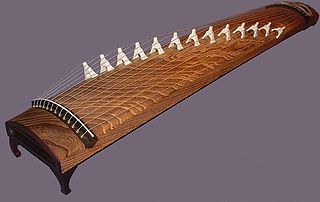
The koto is a Japanese plucked half-tube zither instrument, and the national instrument of Japan. It is derived from the Chinese zheng and se, and similar to the Mongolian yatga, the Korean gayageum and ajaeng, the Vietnamese đàn tranh, the Sundanese kacapi and the Kazakh jetigen. Koto are roughly 180 centimetres (71 in) in length, and made from Paulownia wood. The most common type uses 13 strings strung over movable bridges used for tuning, different pieces possibly requiring different tuning. Seventeen-string koto are also common, and act as bass in ensembles. Koto strings are generally plucked using three fingerpicks, worn on the first three fingers of the right hand.

Zithers are a class of stringed instruments. Historically, it could be any instrument of the psaltery family. In modern terminology, it is more specifically an instrument consisting of many strings stretched across a thin, flat body, the topic of this article.

Korea has produced music from thousands of years, until the modern day. After the division of Korea in 1945, both North and South Korea have produced their own styles of music.

The gayageum or kayagum is a traditional Korean musical instrument. It is a plucked zither with 12 strings, though some more recent variants have 18, 21 or 25 strings. It is probably the best known traditional Korean musical instrument. It is based on the Chinese guzheng and is similar to the Japanese koto, Mongolian yatga, Vietnamese đàn tranh, Sundanese kacapi and Kazakh jetigen.

The guqin is a plucked seven-string Chinese musical instrument. It has been played since ancient times, and has traditionally been favoured by scholars and literati as an instrument of great subtlety and refinement, as highlighted by the quote "a gentleman does not part with his qin or se without good reason," as well as being associated with the ancient Chinese philosopher Confucius. It is sometimes referred to by the Chinese as "the father of Chinese music" or "the instrument of the sages". The guqin is not to be confused with the guzheng, another Chinese long stringed instrument also without frets, but with moveable bridges under each string.
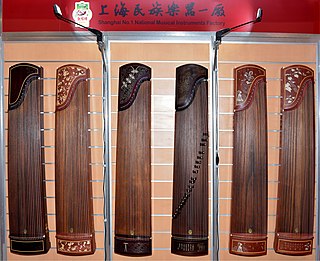
The zheng or guzheng, is a Chinese plucked zither. The modern guzheng commonly has 21, 25, or 26 strings, is 64 inches long, and is tuned in a major pentatonic scale. It has a large, resonant soundboard made from Paulownia wood. Other components are often made from other woods for structural or decorative reasons. Guzheng players often wear a fingerpick made from materials such as plastic, resin, tortoiseshell, or ivory on one or both hands.

The ruan is a traditional Chinese plucked string instrument. It is a lute with a fretted neck, a circular body, and four strings. Its four strings were formerly made of silk but since the 20th century they have been made of steel. The modern ruan has 24 frets with 12 semitones on each string, which has greatly expanded its range from a previous 13 frets. The frets are commonly made of ivory or in recent times of metal mounted on wood. The metal frets produce a brighter tone as compared to the ivory frets. It is sometimes called ruanqin, particularly in Taiwan.
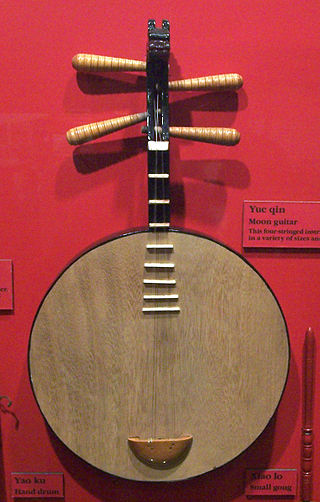
The yueqin, also called a moon lute or moon guitar, is a traditional Chinese string instrument. It is a lute with a round, hollow soundboard, a short fretted neck, and usually four strings. It is an important instrument in the Peking opera orchestra, often taking the role of main melodic instrument in lieu of the bowed string section.

The konghou is a Chinese plucked string instrument. In ancient China, the term konghou came to refer to three different musical instruments: a zither and two different types of harp.

The se or guse is an ancient plucked zither of Chinese origin. It varied in size and construction, but generally had 25–50 strings with moveable bridges and a range of up to five octaves. It was one of the most important stringed instruments in China, along with the guqin. The se gradually faded out of use, having evolved into the similar zheng. Modern versions of the se often resemble the zheng, and attempts have been made to revive the instrument.

Traditional Korean musical instruments comprise a wide range of string, wind, and percussion instruments. Many traditional Korean musical instruments derive from Chinese musical instruments.
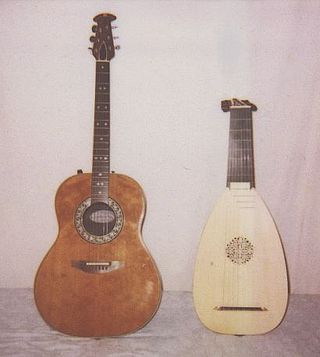
Plucked string instruments are a subcategory of string instruments that are played by plucking the strings. Plucking is a way of pulling and releasing the string in such a way as to give it an impulse that causes the string to vibrate. Plucking can be done with either a finger or a plectrum.
The history of the guqin, an ancient Chinese musical instrument, is a long one that spans 3,000 years. Although similar, it should not be confused with another Chinese zither instrument, the guzheng, which has bridges.
The playing techniques of the guqin, sometimes called fingerings, are more numerous than those of any other Chinese or Western musical instrument.
The strings of the guqin Chinese zither are either made of silk, nylon or metal-nylon.

The bipa is a pear-shaped lute that is a traditional Korean musical instrument. It is derived from Chinese pipa and was introduced through the Silk Road to Goguryeo and Silla. There are two major types of bipa: the four stringed dang-bipa and the five stringed hyang-bipa. While dang-bipa was a Tang-style pipa first introduced from the Chinese Tang dynasty and localized over time to have Korean characteristics, hyang-bipa was created in the Korean Kingdom of Silla. The instrument is also related to other derivatives such as Vietnamese đàn tỳ bà and the Japanese biwa.
Wang San-ak was the prime minister of Goguryeo during the reign of King Yangwon.
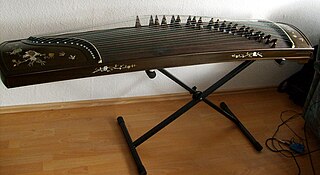
The yatga (Mongolian: ᠶᠠᠲᠤᠭᠠ, romanized: yatug-a, Khalkha dialect: ятга, yatga; pronounced[ˈjɑtʰəq]; is a traditional plucked zither of Mongolia.

Tablature is a form of musical notation indicating instrument fingering or the location of the played notes rather than musical pitches.

The tube zither is a stringed musical instrument in which a tube functions both as an instrument's neck and its soundbox. As the neck, it holds strings taut and allows them to vibrate. As a soundbox, it modifies the sound and transfers it to the open air. The instruments are among the oldest of chordophones, being "a very early stage" in the development of chordophones, and predate some of the oldest chordophones, such as the Chinese Se, zithers built on a tube split in half. Most tube zithers are made of bamboo, played today in Madagascar, India, Southeast Asia and Taiwan. Tube zithers made from other materials have been found in Europe and the United States, made from materials such as cornstalks and cactus.

















